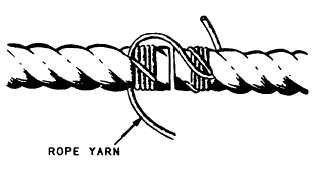| |
A recommended method of securing gantlines is
diagrammed in figure 4-30. The end of the chair gant-
line is secured to the end of the dummy gantline by
butting the two ends together and seizing with turns of
rope yarn back and forth between strands, so everything
will pass through the sheave without fouling. The chair
gantline is hauled up and through by the dummy gant-
line, the chair is heaved from the deck to the crosstree,
and the hauling part is passed down to the party on deck.
Never attempt to hoist the chair aloft with the
dummy gantline. All tools and equipment are attached
to the chair so hands are free and to ensure the safety of
anyone below from falling objects. When you are ready
to go up, and the deck crew is ready to heave around,
get in the chair and give a signal for them to pull you up.
Help them by hauling down on the hauling part. Keep
your hands clear of the part the chair is on or they may
get jammed into the sheave when you are two-blocked
to the truck. When the desired working height has been
reached, signal the crew below and sing out “AVAST
HEAVING”. The deck crew will stop pulling and hold
the chair in place. Reach above the double becket bend
and firmly squeeze the two parts of the gantline
together. When you have a good grasp, command the
deck crew “UP BEHIND.” This tells them to let go of
the gantline. Warning: At this point, your grasp keeps
the chair from falling. With your right hand, pull the
gantline through the bridle and squeeze them together
just above the double becket bend. Now the strain is on
the bridle as in the first view of figure 4-31.
With your free left hand, pull up some slack from
below so you have enough to pass over your head, clear
around the chair, and under your feet, as in the second
view of figure 4-31. The maneuver is a bit tricky,
especially if you have a bucket or two hanging on the
chair, but you will not have any trouble if you have
enough slack pulled up. Keep hold of the gantline with
your right hand until you have worked the hitch up to
the apex of the bridle as shown in the third view of
figure 4-31. Then hold the two parts of the gantline
Figure 4-30.–Method of securing gantlines.
above your right hand with your left, and work the rest
of the slack down.
You are now in no danger of falling, and all you
have to do to lower the boatswain's chair is pull up slack
and pass it around. Before you go aloft for the first time,
though, you should practice hanging off deck a few
times.
RIDING DOWN STANDING RIGGING
Standing rigging usually leads too far out from the
mast for you to lower yourself when slushing down.
Someone must lower you from on deck.
In riding down standing rigging, bend the tail of
your gantline (fig. 4-31) to a shackle placed around the
wire. Never place the shackle pin on the wire. It may
unscrew as it travels along, and if it opens and lets go,
you will swing back against the mast hard enough to
injure yourself. Always put the bow of the shackle
around the wire.
Personnel must adhere to the following safety pre-
cautions when working aloft:
Obtain permission from the officer of the deck
before going aloft.
Make sure radio and radar units are OFF and that
antennas are guarded. A “man aloft chit” is processed to
ensure that key personnel are aware of any work being
done aloft. The chit is signed by the ship’s electrical
maintenance officer (EMO), communications officer
(COMMO), and command duty officer (CDO).
Tools and equipment will be tied to the
boatswain's chair to prevent objects from falling on
personnel below.
Wear a safety harness and secure it to a fixed
object above you once you are aloft.
WORKING OVER THE SIDE
LEARNING OBJECTIVE: Explain the
procedures for working over the side and
taking soundings.
Personnel preparing to work over the side should
notify the officer of the deck (OOD). Upon securing,
personnel should again notify the OOD.
All personnel working over the side of the ship on
stages, boatswain's chairs, and on work floats or boats
along the side of the ship are required to wear life
4-38
|

